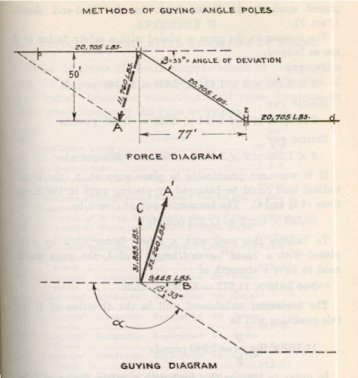![]()

General Order 64-A
Appendix
F
Typical Problems
PART 3
Methods Of Providing Proper Strength For Unbalanced Conductor Stresses At Angle Poles
To maintain poles in proper position at angles and
corners, it is generally necessary to use guys or some other form of pole
bracing. Unless the line is dead–ended, the pull of the conductors is taken as
being the same throughout the line.
The degree of unbalanced pull at an angle or corner pole is dependent upon the
angle in the line at that point; that is, the greater the angle in the line,
the greater is the magnitude of unbalance. Rule 47.3 specifies that when the
longitudinal loads in a structure are not normally balanced, the members
stressed shall be of such strength as to withstand the total unbalanced load
with factors of safety equal to those of Table 4. As it is assumed that the line considered in this problem is
Grade “A” construction, the pole would be required to provide a safety factor
of 4 against unbalanced loads; where guys are used to take the unbalanced loads
they must provide a safety factor of 2.
It is assumed that the line discussed in the foregoing dead-end problem crosses
from one side of a street to the opposite side, that the longitudinal distance
along the street between the two poles concerned is 77 feet, and the angle (β)
of deviation is 33° (see sketch). This would result in an unbalanced force
being exerted in the direction of A (see force diagram) of
![]()

Assuming the pole height and framing as shown in Part 2, the top circumference of pole to be 25 inches the ground circumference to be 48 inches and the center of load to be 38.5 feet above ground line (as determined in Part 2), the fiber stress on the pole at the ground line is as follows:
Bending moment = 38.5 X 11,760 = 452,760 foot-pounds
Fiber stress = 
As a safety factor of 4 is required, the use of guys is necessary to hold this strain.
In order not to overstress the pole at the point of guy attachments, 3 ⅝ inch guy strands are found adequate when placed similarly to those shown in the dead-end sketch (Part 2).
The stresses on the guys so placed with a safety factor of 2 are as follows:
Top guy
3 x 2,375 x 2 1.414 x .5680 = 11,445 pounds
Middle guy
4 x 1,520 x 2 1.414 x .5680 = 9,765 pounds
Bottom guy
3 x 1,520 x 2 1.414 x .5680 = 7,325 pounds
If it were not practicable to place guys at A, the longitudinal load could be balanced by placing guys in the directions of B and C. The horizontal pill at C will be
20,705 x Sin β =11,275 pounds
To balance this load with a safety factor of 2 by guys placed with a “lead” over “height” of 1, the guys would need to have a strength of
2 x 1.414 x 11,275 = 31,885 pounds
The horizontal unbalanced pull in the direction of B for this condition will be
![]()
In order to balance this load with a safety factor of 2 by guys placed with a “lead” over “Height” of 1, the guys must have an ultimate strength of
2 x 1.414 x 3,340 = 9,445 pounds
The angle pole (2) on opposite side of the street would be subject to similar unbalanced stresses, hence it must be guyed in a like manner.
As indicated above, the foregoing calculations are based on the minimum sags allowed at 60 degrees F. Since the tension in conductors varies inversely as the sag, the unbalanced pull at the angle poles in this problem could have been reduced by increasing the sag in the conductors, thus decreasing the guy loads.